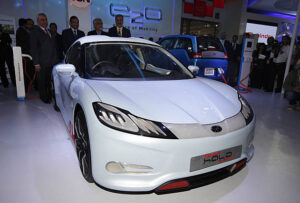The Future of Electric Vehicles

The EVclouts is posting the Future of Electric Vehicles: Electric vehicles (EVs) are vehicles that are powered by electricity stored in a battery pack. They use one or more electric motors to propel the vehicle instead of an internal combustion engine (ICE) that runs on fossil fuels. Here are some key points about electric vehicles:
Electric vehicles (EVs) have been around for a while, but its only in recent years that they have started capturing the publics imagination. With climate change a growing concern, more and more people are looking for ways to reduce their carbon footprint, and EVs offer a promising solution. In fact, in 2020, EV sales increased by 43% in the US, and this trend is expected to continue.
One reason for this shift is the increasing affordability of EVs. As battery technology has improved, the cost of producing EVs has fallen, making them more accessible to the average consumer. In addition, many governments around the world are offering incentives and subsidies to encourage people to switch to EVs.
Would the Future of Electric Vehicles will get Advantage ?
There are many reasons why people are making the switch to EVs. For one thing, theyre environmentally friendly. EVs produce zero emissions, which is good news for the planet. Theyre also more energy-efficient than traditional vehicles, which means theyre cheaper to run.
Over the lifetime of an EV, the cost of fuel and maintenance is significantly lower than that of a gas-powered car.
Environmental Benefits: Electric vehicles produce zero tailpipe emissions, which helps reduce air pollution and greenhouse gas emissions. They contribute to a cleaner and more sustainable transportation sector, particularly when paired with renewable energy sources for charging.
- Types of Electric Vehicles: a. Battery Electric Vehicles (BEVs): These vehicles run solely on electricity and rely on a large battery pack to store energy. They need to be charged from an external power source, such as a charging station or home charger.
- Plug-in Hybrid Electric Vehicles (PHEVs): PHEVs combine an electric motor with an internal combustion engine. They can run on electric power alone for shorter distances and switch to the gasoline engine for longer trips or when the battery is depleted.
- Charging Infrastructure: Charging an electric vehicle requires access to charging infrastructure. There are different types of charging options: Level 1 Charging: This involves using a standard household outlet (120 volts) to charge the vehicle. It is the slowest charging method.
- Level 2 Charging: This utilizes a higher-powered charging station (240 volts) and offers faster charging speeds compared to Level 1. c. DC Fast Charging: This is the fastest charging option and is typically available at public charging stations. It can charge the vehicle to 80% or more in a short time, usually within 30-60 minutes.
- Range and Battery Technology: Electric vehicles have varying ranges depending on the model and battery capacity. Advances in battery technology have led to improvements in range and charging speed over time.
- Cost and Incentives: Electric vehicles generally have a higher upfront cost compared to conventional ICE vehicles. However, operational costs, including fuel and maintenance, tend to be lower. Additionally, there may be government incentives, tax credits, and subsidies available to promote electric vehicle adoption and offset some of the costs.
- Advancements and Future Outlook: The electric vehicle market is rapidly evolving, with advancements in battery technology, increased driving range, and the introduction of new models.
- Automakers are investing in electric vehicle development, and there is growing infrastructure support for charging stations to accommodate the increasing number of electric vehicles on the road.
Another benefit of EVs is their performance. Electric motors provide instant torque, which means they can accelerate more quickly than gas-powered cars. They Are also quieter and smoother to drive, making for a more comfortable ride.
The Future of Electric Vehicles
The future of EVs looks bright. With advancements in battery technology, EVs will be able to travel longer distances on a single charge, making them even more practical for everyday use. In addition, charging infrastructure is improving, with more and more charging stations being installed around the world.
As the demand for EVs grows, we can expect to see more innovation and competition in the market. This will lead to even more affordable and practical EVs. Some experts predict that by 2040, over half of all vehicles sold will be electric.
Conclusion of Future of Electric Vehicles
Electric vehicles are the future. Theyre environmentally friendly, energy-efficient, and offer great performance. As battery technology and charging infrastructure continue to improve, we can expect to see more and more people making the switch to EVs. So why not join the green revolution and switch to an electric vehicle today?
See More on Future of Electric Cars
https://evclouts.com/?page_id=437
Evehicleshop – all about Electric scooters, Bikes, & Electric Cars (electricalvehiclee.com)









